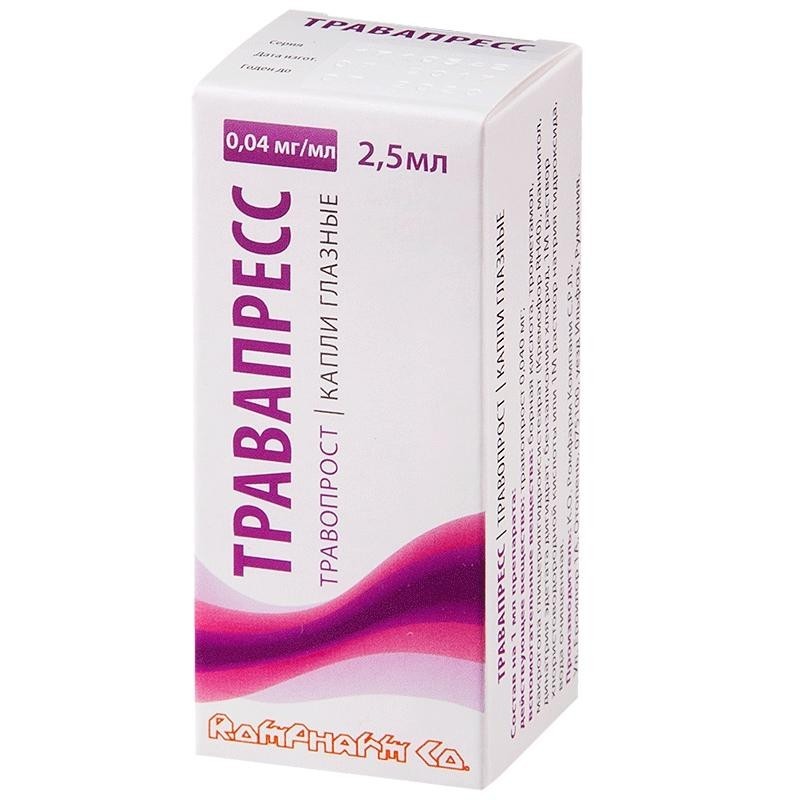



Travoprost, a synthetic analogue of prostaglandin P2-alpha, is a highly selective agonist of prostaglandin FP receptors and reduces intraocular pressure by increasing the outflow of aqueous humor. The main mechanism of drug action is associated with an increase in uveoscleral outflow. Does not have a significant impact on the production of aqueous humor.
Timolol is a non-selective blocker of beta-adrenoreceptors without sympathomimetic activity, does not have a direct depressive effect on the myocardium, does not possess membrane stabilizing activity. When applied topically reduces intraocular pressure by reducing the formation of aqueous humor and a small increase in its outflow.
Intraocular pressure decreases approximately 2 hours after application, and the maximum effect is achieved after 12 hours. A significant reduction in intraocular pressure may persist for 24 hours after a single use of the drug.
Pharmacokinetics
Travoprost and timolol are absorbed through the cornea. In the cornea hydrolysis of travoprost to the biologically active form - travoprost occurs.
Travoprost after topical administration is rapidly removed from the plasma within an hour — the plasma concentration decreases below the detection threshold — less than 0.01 ng / ml (can vary from 0.011 ng / ml to 0.02 ng / ml).
Maximum concentration (C max a) plasma timolol is 0.692 ng / ml and persists up to the detection threshold for 12 hours, and T max timolol is achieved within an hour after topical administration.
T 1/2 timolol is 4 hours after topical application of DuoTrav.
Travoprost is excreted in the form of inactive metabolites mainly with bile (61%). Travoprost free acid and its metabolites are excreted by the kidneys. Less than 2% of travoprost is found in the urine in the form of free acid.
Timolol and formed metabolites are excreted mainly by the kidneys. About 20% of timolol is excreted unchanged, the rest in the form of metabolites.
Reducing elevated intraocular pressure in open-angle glaucoma and intraocular hypertension in patients resistant to monotherapy with beta-blockers or analogues.
Travoprost is marketed under different brands and generic names, and comes in different dosage forms:
| Brand name | Manufacturer | Country | Dosage form |
|---|---|---|---|
| Cyclogemal | eye drops | ||
| Travatan | Alcon | USA | eye drops |
No customer reviews for the moment.
The drug is instilled in 1 drop in the conjunctival sac of the affected eye (s) 1 time per day, preferably in the evening. More frequent use of the drug can lead to a decrease in its effectiveness.
On the part of the organ of vision: in 35% of cases, transient mild conjunctival hyperemia, passing independently; in 5-10% of cases - a decrease in visual acuity, discomfort and a foreign body, pain, itching, burning in the eyes; in 1-4% of cases - visual disorders, blepharitis, "fog" before the eyes, cataracts, conjunctivitis, dry conjunctiva, changes in the color of the iris, keratitis, formation of crusts on the edges of the eyelids, photophobia, subconjunctival hemorrhage and increased tearing.
Since the cardiovascular system: in 1-5% of cases - increase or decrease in blood pressure, bradycardia, angina pectoris, chest pain, hypercholesterolemia.
From the side of the central nervous system: in 1-5% of cases - general anxiety, headache, depression.
From the urinary system: in 1-5% of cases - urinary incontinence and urinary system infections.
From the musculoskeletal system: in 1-5% of cases - arthritis, back pain.
Other: in 1-5% of cases - flu-like syndrome, sinusitis, bronchitis, dyspepsia.
WITH caution It should be prescribed to patients with risk factors for the development of macular edema (aphakia, pseudophakia, damage to the posterior lens capsule), in acute iritis, uveitis.
Interaction with other drugs is currently not established.
The purpose of the drug during pregnancy is contraindicated.
Sufficient experience of the drug during lactation is not. Application during breastfeeding is possible only under the supervision of a physician and only in the case when the expected therapeutic effect for the mother exceeds the risk of the development of possible side effects for the child.
The drug may cause a gradual change in eye color by increasing the amount of brown pigment in the iris. This effect is detected mainly in patients with mixed colors of the iris, for example, blue-brown, gray-brown, green-brown or yellow-brown, which is explained by an increase in the content of melanin in the stromal melanocytes of the iris. Usually brown pigmentation spreads concentrically around the pupil to the periphery of the iris of the eye, while the entire iris or its parts may acquire a more intense brown color.
In patients with evenly colored blue, gray, green or brown eyes, changes in eye color after two years of use were very rare. The color change is not accompanied by any clinical symptoms or pathological changes.
After discontinuation of the drug, no further increase in the amount of brown pigment was observed, however, the color change that has already developed may be irreversible.
Before treatment, patients should be informed about the possibility of changing the color of the eyes.
Treatment of only one eye can lead to permanent heterochromia.
In the presence of nevi or lentigo on the iris, their changes under the influence of the drug are not marked.
The drug may cause darkening, thickening and lengthening of eyelashes and / or an increase in their number; rarely darkening of the eyelid skin.
Travatan can be used in combination with other antiglaucoma drugs for local use. In this case, the interval between their use should be at least 5 minutes.
When wearing contact lenses before instillation of the drug, the lenses should be removed and installed back no earlier than 20 minutes after the procedure.
The bottle must be closed after each use.
Symptoms: irritation of the mucous membrane of the eye, conjunctival hyperemia or episclera.
Treatment: conduct symptomatic therapy.
Studies and clinical trials of Travoprost (Click to expand)